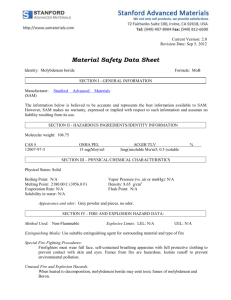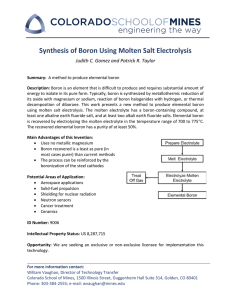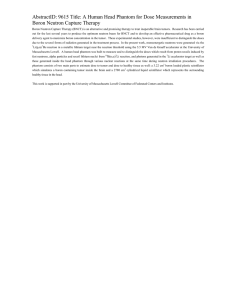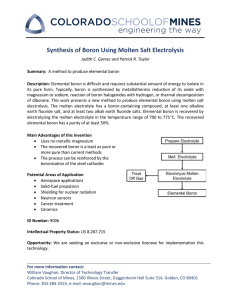Effect of boron and molybdenum application on
advertisement
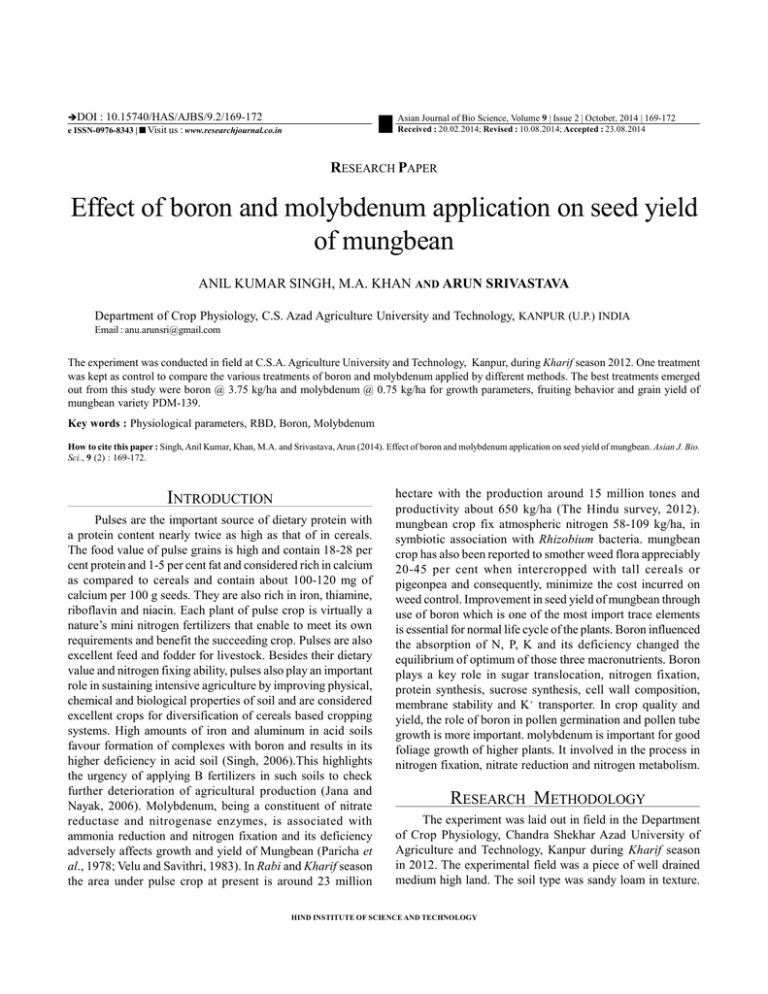
DOI : 10.15740/HAS/AJBS/9.2/169-172 e ISSN-0976-8343 | Visit us : www.researchjournal.co.in Asian Journal of Bio Science, Volume 9 | Issue 2 | October, 2014 | 169-172 Received : 20.02.2014; Revised : 10.08.2014; Accepted : 23.08.2014 RESEARCH PAPER Effect of boron and molybdenum application on seed yield of mungbean ANIL KUMAR SINGH, M.A. KHAN AND ARUN SRIVASTAVA Department of Crop Physiology, C.S. Azad Agriculture University and Technology, KANPUR (U.P.) INDIA Email : anu.arunsri@gmail.com The experiment was conducted in field at C.S.A. Agriculture University and Technology, Kanpur, during Kharif season 2012. One treatment was kept as control to compare the various treatments of boron and molybdenum applied by different methods. The best treatments emerged out from this study were boron @ 3.75 kg/ha and molybdenum @ 0.75 kg/ha for growth parameters, fruiting behavior and grain yield of mungbean variety PDM-139. Key words : Physiological parameters, RBD, Boron, Molybdenum How to cite this paper : Singh, Anil Kumar, Khan, M.A. and Srivastava, Arun (2014). Effect of boron and molybdenum application on seed yield of mungbean. Asian J. Bio. Sci., 9 (2) : 169-172. INTRODUCTION Pulses are the important source of dietary protein with a protein content nearly twice as high as that of in cereals. The food value of pulse grains is high and contain 18-28 per cent protein and 1-5 per cent fat and considered rich in calcium as compared to cereals and contain about 100-120 mg of calcium per 100 g seeds. They are also rich in iron, thiamine, riboflavin and niacin. Each plant of pulse crop is virtually a nature’s mini nitrogen fertilizers that enable to meet its own requirements and benefit the succeeding crop. Pulses are also excellent feed and fodder for livestock. Besides their dietary value and nitrogen fixing ability, pulses also play an important role in sustaining intensive agriculture by improving physical, chemical and biological properties of soil and are considered excellent crops for diversification of cereals based cropping systems. High amounts of iron and aluminum in acid soils favour formation of complexes with boron and results in its higher deficiency in acid soil (Singh, 2006).This highlights the urgency of applying B fertilizers in such soils to check further deterioration of agricultural production (Jana and Nayak, 2006). Molybdenum, being a constituent of nitrate reductase and nitrogenase enzymes, is associated with ammonia reduction and nitrogen fixation and its deficiency adversely affects growth and yield of Mungbean (Paricha et al., 1978; Velu and Savithri, 1983). In Rabi and Kharif season the area under pulse crop at present is around 23 million hectare with the production around 15 million tones and productivity about 650 kg/ha (The Hindu survey, 2012). mungbean crop fix atmospheric nitrogen 58-109 kg/ha, in symbiotic association with Rhizobium bacteria. mungbean crop has also been reported to smother weed flora appreciably 20-45 per cent when intercropped with tall cereals or pigeonpea and consequently, minimize the cost incurred on weed control. Improvement in seed yield of mungbean through use of boron which is one of the most import trace elements is essential for normal life cycle of the plants. Boron influenced the absorption of N, P, K and its deficiency changed the equilibrium of optimum of those three macronutrients. Boron plays a key role in sugar translocation, nitrogen fixation, protein synthesis, sucrose synthesis, cell wall composition, membrane stability and K+ transporter. In crop quality and yield, the role of boron in pollen germination and pollen tube growth is more important. molybdenum is important for good foliage growth of higher plants. It involved in the process in nitrogen fixation, nitrate reduction and nitrogen metabolism. RESEARCH METHODOLOGY The experiment was laid out in field in the Department of Crop Physiology, Chandra Shekhar Azad University of Agriculture and Technology, Kanpur during Kharif season in 2012. The experimental field was a piece of well drained medium high land. The soil type was sandy loam in texture. HIND INSTITUTE OF SCIENCE AND TECHNOLOGY ANIL KUMAR SINGH, M.A. KHAN AND ARUN SRIVASTAVA Soil pH 7.5 and had 0.52 per cent organic carbon, 0.056 per cent total nitrogen, 15 ppm available phosphorus and 78 ppm available potash, in addition to above also had 54.20 per cent fine sand and 14.0 per cent clay. boron and molybdenum were applied in concentrations through soil application as basal. 0.1 and 0.2 per cent boron solution was sprayed on plants before flowering and quantities of borax were applied at flowering in other treatment. Thus one treatment was kept as control to compare the various treatments of boron and molybdenum applied by different methods. The variety of mungbean was PDM-139, number of replications was 3, field size was 13.0m x 10.8m and plot size was 2m x 1m. Sowing date of this experiment was 1 August, 2012 and at 24 October 2012 plant were harvested individually with the help of sickle. Threshing was done manually and weight of seed obtained from each plant was recorded separately by weight balance. Ten plants were taken from each plot to measure the yield attributes. following the Randomized block design model and the variation among the treatment means was tested for significance of analysis of variance technique. Levels of significance used for t-test was p<0.05 given by Fisher (1970). The critical difference was also worked out. RESEARCH FINDINGS AND ANALYSIS Data presented in Table 1 regarding plant height, significantly was recorded maximum in treatment boron @ 3.75 kg/ha through soil application (43.05 cm) followed by treatment boron @ 2.50 kg/ha through soil application (41.29 cm) and Mo @ 0.75 kg/ha through soil application (41.04 cm). Control recorded lowest value over all treatment. Higher growth attributes were observed by Singh et al. (2012), Pal (2010) and Awomi et al. (2011). The result suggested that beneficial effect of boron and molybdenum application through different treatment were initiated during the early stage of growth and has been carried over at successive stage of plant growth. Molybdenum @ 0.75 significantly given good response in the dry weight of pod/plant followed by boron @ Statistical analysis : Data obtained were subjected to statistical analysis Table 1 : Effect of boron and molybdenum on plant height, dry wt. pod per plant wt. of plant, chlorophyll content, seeds per pod, leaf area per plant, grain yield, harvest index and RGR Sr. Plant height Dry wt. Dry wt. of Chlorophyll Seeds Leaf area/ Grain Harvest RGR Treatments no. (cm) pod/plant (g) plant (g) content per pod plant (cm2) yield (g) index (mg/g/day) 1. Control 36.75 2.72 6.28 44.85 9.33 841.67 2.26 36.06 12.75 2. Boron 1.25 kg/ha 38.50 4.29 10.11 3. Boron 2.50 kg/ha 41.29 6.06 13.34 46.86 9.78 906.67 3.89 38.52 18.50 48.05 10.00 978.33 5.09 39.02 4. Boron 3.75 kg/ha 43.05 6.75 19.35 15.12 49.98 10.89 1048.33 6.26 41.38 5. Boron 5.00 kg/ha 37.62 3.24 20.69 7.11 45.17 9.44 873.33 2.61 36.74 17.21 6. Mo 0.25 kg/ha 38.01 7. Mo 0.50 kg/ha 39.02 4.21 9.78 46.93 9.89 911.67 3.75 38.60 17.16 5.03 10.79 48.12 10.22 1021.67 4.22 39.11 8. Mo 0.75 kg/ha 18.50 41.04 7.03 13.22 50.33 11.00 1108.33 5.75 43.52 9. Mo 1.00 kg/ha 21.34 37.03 3.22 7.04 45.29 9.56 886.67 2.65 37.73 17.09 S.E. ± 0.34 0.05 0.32 0.19 0.41 7.56 0.28 1.34 1.22 C.D. (P = 0.05) 0.72 0.11 0.69 0.41 0.87 16.16 0.55 2.86 2.61 Harvest index RGR (mg/g/day) Table 2 : Correlation co-efficient between physiological parameters Plant Dry wt. Dry wt. of Chlorophyll height (cm) pod/plant (g) plant (g) content Seeds per pod Leaf area/ plant (cm2) Grain yield (g) Plant height(cm) 1 Dry wt. pod/plant 0.9493* 1 Dry wt. of plant (g) 0.9727* 0.9723* 1 Chlorophyll content 0.9080* 0.9805* 0.9486* 1 Seeds per pod 0.8673* 0.9424* 0.8902* 0.9812* 1 Leaf area/plant 0.8381* 0.9451* 0.8691* 0.9678* 0.9669* 1 Grain yield 0.9680* 0.9871* 0.9915* 0.9768* 0.9389* 0.9105* 1 H.I. 0.8013* 0.9236* 0.8418* 0.9517* 0.9705* 0.9462* 0.9006* 1 RGR 0.8260* 0.8888* 0.8584* * indicates of significance of values at P=0.05, respectively 0.8703* 0.8485* 0.8599* 0.8771* 0.8726* 170 Asian J. Bio Sci., 9 (2) Oct., 2014 : 169-172 Hind Institute of Science and Technology 1 EFFECT OF BORON & MOLYBDENUM APPLICATION ON SEED YIELD OF MUNGBEAN 2.50 kg/ha and 3.75 kg/ha applied through soil application. Dry weight of plant significantly increased with the application of boron @ 3.75 kg/ha followed by boron @ 2.50 kg/ha and molybdenum @ 0.75 kg/ha. boron and molybdenum applied through different recommended treatments were also effective in increasing dry matter production of plant with the findings of Chakraborty (2009), Shankhe et al. (2003) and Bandyopadhyay and basu (2003). Seeds per pod showed significant beneficial effects of molybdenum @ 0.75 kg/ha and boron @ 3.75 kg/ha through soil application which was clearly reflected on yield and yield attributes of mungbean. Similar findings were reported by Kushwaha (1999) and Srinivasan et al. (2007). Grain yield was significantly maximum with boron @ 3.75 kg/ha followed by molybdenum @ 0.75 kg/ha and boron @ 2.50 kg/ha applied through soil application. Harvest index was significantly maximum in molybdenum @ 0.75 kg/ha applied through soil application, this finding is quit similar with those reported by Howeler et al. (1978), Dwivedi et al. (1990) and Gupta (1993). Relative growth rate under the influence of different treatment of boron and molybdenum application did not record many variants. However, there was indication that molybdenum @ 0.75 kg/ha had some favorable effects towards RGR. Thus, other treatment of boron and molybdenum applied through soil application were equally effective in increasing RGR over control. Pal (2010) reported that RGR decreased with the advancement of the age in mungbean. Chlorophyll intensity of plant was recorded highest in boron @ 3.75 kg/ha over control. Application of boron and molybdenum improved in the term of stem chlorophyll and carotene oil content. Boron spray improved the sex ratio and early production of fruit and gave high fruit yields reported by El-Yazied et al. (2007). Table 2 shows the correlation coefficients between physiological parameters, gave significant response to each other. The present study has clearly brought about significant changes in growth and fruiting behavior of mungbean variety PDM-139 with the soil application of varying level of boron and molybdenum. The best treatments emerged out from this study were boron @ 3.75 kg/ha and molybdenum @ 0.75 kg/ha for growth parameters, fruiting behaviors and grain yield of mungbean variety PDM-139. Working with different crops other researchers have also reported increased yield of different crops with application of boron (Sakal and Singh, 1995; Sharma, 2006; Singh, 2001; Singh, 2006), molybdenum (Singh, 2006) and micronutrient mixtures containing boron and molybdenum (Kumpawat and Manohar, 1994; Revathy et al., 1997; Jayaball et al., 1999; Manivannan et al., 2001). The result presented in this report clearly brought out the need and the benefit of application of boron and molybdenum for improving pulse production in acidic soils of the state. LITERATURE CITED Awomi, T.A., Singh, A.K., Singh, A.P. and Bordoloi, L.J. (2011). Effect of phosphorus, molybdenum and cobalt on growth yield and nutrient content of mungbean and soil fertility. J. Soil & Crops, 21(2): 158-164. Bandyopadhyay, S.R. and Basu, T.K. (2003). Response of greengram varieties to molybdenum application and Rhizobium inoculation in respect of nodulation and yield. J. Mycopathological Res., 41(2): 189-192. Chakraborty, A. (2009). Growth and yield of lentil as affected by boron and molybdenum application in lateritic soil. J. Crop & Weed, 5(1): 96-99. Dwivedi, B.S., Ram, M., Singh, B.P., Das, A.N. and Prasad, R.N. (1990). Different response of crop to boro fertilization in acid Alfisol. Indian J. Agric. Sci., 60(20): 122-127. El Yazeid, A.A., Abou Aly, H.E., Mady, M.A. and Moussa, SAM. (2007). Enhancing growth, productivity and quality of squash plant using phosphate dissolving micro organism combined with boron foliar spray. Res. J. Agric. & Biol. Sci., 3(4): 274-286. Fisher, R.A. (1970). Statistical methods of research. John Willey and Sons, New York (U.S.A.). Gupta, M. (1993). Growth and yield in Vicia faba L. in relation to mineral spray. Indian J. Appl. & Pure Biol., 4(2): 179-183. Howeler, R.H., Flor, C.A. and Gonzalog, C.S. (1978). Correction of B deficiency in beans and mungbean in a willisol from the cauca valley Colombia. Colombian Agron. J., 70 : 493-497. Jana, D. and Nayak, S.C. (2006). Progress report of All India co-ordinated researh project on micro and secondary nutrients in soils and plants. Orissa University of Agriculture and Technology, Bhubaneswar (ORISSA) INDIA. Jeswani, L.M. and Baldev, B. (1997). Advances in pulse production technology, ICAR, Krishi Anusandhan Bhavan, Pusa, NEW DELHI, INDIA. Jayaball, A., Palaniappan, S.P. and Chelliah, S. (1999). Effects of foliar application of new soluble fertilizers on soybean. Andhra Agric. J., 46: 243-44. Asian J. Bio Sci., 9 (2) Oct., 2014 : 169-172 Hind Institute of Science and Technology 171 ANIL KUMAR SINGH, M.A. KHAN AND ARUN SRIVASTAVA Kumpawat, B.S. and Manohar, S.S. (1994). Effect of Rhizobium inoculation, phosphorus and micronutrients on nodulation and protein content of gram. Madras Agric. J., 81: 630-631. Kushwaha, B.L. (1999). Studies on response of French bean to zinc, boron and molybdenum application. Indian J. Pulses Res., 12(1): 4448. Manivannan, V., Thanunathan, K. Imayavaramban, V., Ramanathan, N. and Singaravel, R. (2001). Foliar application of nutrients: A low cost technology for yield maximization in rice-fallow pulse. Res. Crops, 2: 289-292. Pal, A.K. (2010). Effect of Rhizobium inoculation and application of phosphorus and molybdenum on growth and yield in blackgram. Adv. Pl. Sci., 23(1): 53-55. Paricha, P.C., Sahoo, N.C. and Kar, M. (1978). Significance of molybdenum and applied nitrogen on the chemical composition and seed yield of green gram [Vigna radiata. (L) Wilczek]. Indian J. Plant Physiology 26:305-313. Revathy, M., Krishnasamy, R. and Chitdeswari, T. (1997). Chelated micronutrients on the yield and nutrient uptake by groundnut. Madras Agric. J., 84 : 649-662. Sakal, R. and Singh, A.P. (1995). Boron research and agricultural production. Micronutrient research and agricultural production (Ed H L S Tandon) FDCO, NEW DELHI, INDIA. Shankhe, G.M., Sonune, B.A., and Naphade, P.S. (2003). Influence of boron and molybdenum on yield and quality of groundnut. Ann. Pl. Physiol. Publ., 16(2): 157-159. Sharma, S.P. (2006). Progress report of Granubor project. Chaudhary Sarwan Kumar Himachal Pradesh Krishi Vishvavidyalaya, Palampur, (H.P.) INDIA. Singh, D.K., Kumar, P., Mishra, Neelam and Singh, A.K. (2012). Interactive effect of cobalt, boron and molybdenum at different fertility status on percentage translocation of nitrogen, phosphorus and sulfur in grain of pea. Environ. & Ecol., 30(2): 262-265. Singh, K. P. (1993). Response of boron and molybdenum in soil of Singbhum and Santal Parganas. Annl. Agric. Res., 14:100-102. Singh, M.V. (2001). Response of micronutrient to crops in different agro-ecological regions- Experiences of AICRP Micronutrients. Fertiliser News, 46:43-49. Singh, M. V. (2006). Micro and secondary nutrients and pollutant element Research in India. AICRP Micronutrient. IISS, Bhopal, 26 :1-82. Smith, F. W. (1982). Mineral nutrition of legumes In: J.M.Vincent (eds.) nitrogen fixation in legumes. Academic Press, Sydney, 155- 172 pp.. Sprent, J.I. and Minchin, F.R. (1983). Environment effects on the physiology of nodulation and nitrogen fixation. In : D.G. Jones and D.R. Davies (EDS.) Temperate Legumes: Physiology, Genetics and Nodulation, Pitman, LONDON, UNITED KINGDOM. Srinivasan, S., Selvi, R.V., Ramesh, S., Pandiyan, M., Sunder, M., Kannan, R. and Marimuthu, R. (2007). Response of mungbean to different methods and levels of molybdenum application under acid soil conditions. Acta Hort., 752: 473-476. Survey of Indian Agriculture (2012). The Hindu. Velu, G. and Savithri,P. (1983). Molybdenum requirement for enhancing the yield of black gram and green gram. Madras Agric. J., 70: 629-630. 9Year of Excellence th 172 Asian J. Bio Sci., 9 (2) Oct., 2014 : 169-172 Hind Institute of Science and Technology
